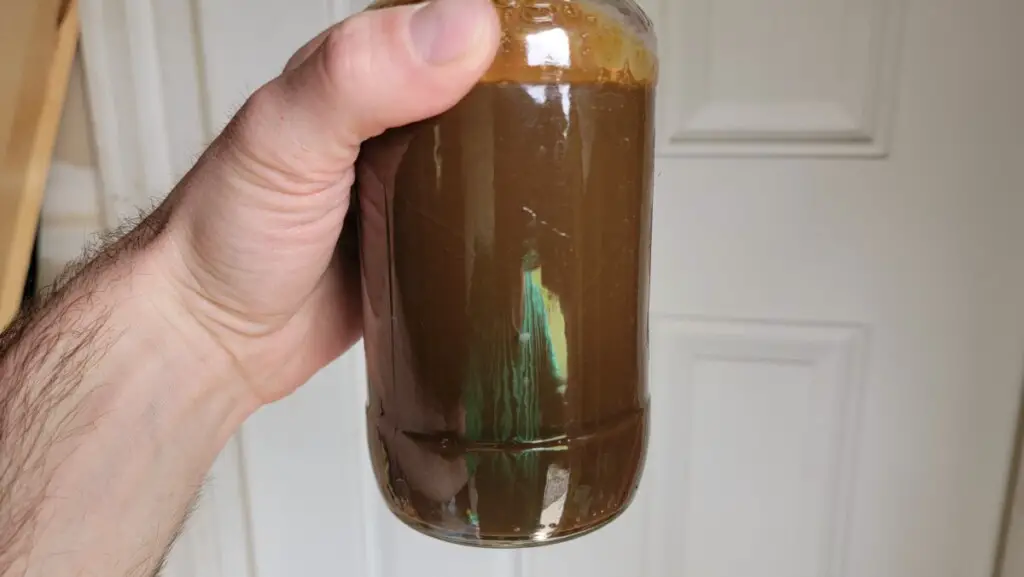As a boat owner, you always want your vessel in top-notch condition. However, you may sometimes encounter puzzling issues, like when your boat engine oil turns the color of chocolate milk. But what’s the reason behind this color change? And more importantly, how much should you worry about it? In this guide, we’ll answer all these questions and more.
What Does It Mean When Your Boat Engine Oil Looks Like Chocolate Milk?
Oil that resembles chocolate milk often signals the presence of water in your boat’s engine. When water mixes with hot engine oil, it creates an emulsion, giving the oil that milky, frothy appearance. This is usually an indication that you have a stuck open thermostat, a blown head gasket, or a cracked block, or an issue with the cylinder walls or piston rings – all of which should be addressed promptly.
For more on repairs for these problems, check out my other article here.

How Much Water Does It Take to Make Oil Milky?
It’s surprising how little water it takes to turn oil milky. Just a few tablespoons of water mixed with a quart of oil can change its appearance. But remember, it’s not just about the look. Water in the oil significantly reduces its lubrication properties, increasing the risk of engine damage.
Now, the exact amount of water needed to turn a boat’s engine oil milky can vary depending on several factors, such as the type of oil used, the temperature, and the specific design of the engine. However, it generally doesn’t take a lot of water to cause this change. As a rule of thumb, if about 1% of the oil volume is water, it may be enough to make the oil appear milky or cloudy.
Let’s consider an engine with an oil capacity of 5 liters, which is roughly 1.3 gallons. 1% of 5 liters is 50 milliliters, or about a 3 tablespoons of water. That’s not much, and it highlights why it’s so important to prevent water from getting into your engine oil in the first place.
However, it’s important to remember that even if the oil does not appear milky, it does not necessarily mean there’s no water in the oil. Water can be present in the oil without causing it to turn milky. It’s always best to have your oil analyzed if you suspect water contamination, as this will give a definitive answer to the presence and quantity of water in your engine oil.
The Effects of Water on Boat Engine Oil
Water can have numerous detrimental effects on boat engine oil, which in turn can cause significant damage to the engine. Here’s what you should know:
- Reduced Lubrication: Engine oil is designed to provide a thin layer of lubrication between engine components, reducing friction and preventing wear and tear. When water mixes with oil, it dilutes the oil, reducing its ability to lubricate effectively. This can lead to increased friction between engine components, causing them to wear out faster and potentially leading to engine failure.
- Corrosion: Water inside the engine can cause internal components to rust. Even small amounts of water can start a corrosive process that damages the metal parts of your engine over time.
- Formation of Sludge: When water mixes with engine oil, it can lead to the formation of sludge, a thick, gooey substance that can clog up your engine. Sludge can block oil passages and prevent oil from reaching vital components of your engine, leading to increased wear and potentially severe engine damage.
- Oil Pressure Issues: Water in the oil can affect the oil’s viscosity and cause foaming, leading to fluctuations in oil pressure. Inadequate oil pressure can cause your engine to run rough, lose power, or even stall out.
- Accelerated Breakdown of Oil: Water in engine oil can also accelerate the breakdown of the oil. Over time, this can lead to the oil losing its protective properties faster than normal, which can result in increased engine wear and damage.

Can I Drive with Milky Oil in My Boat Engine?
Driving your boat with milky oil in its engine is a decision that could lead to significant and costly damage. Milky oil is a clear indication of water contamination in your oil, and this is not something to take lightly.
Water is a poor lubricant, and when it mixes with your engine oil, it greatly reduces the oil’s ability to lubricate your engine’s moving parts. This lack of proper lubrication can lead to increased friction, resulting in parts wearing out more quickly, overheating, or even seizing up entirely, which could cause catastrophic engine failure.
Furthermore, the presence of water in the oil can lead to rust and corrosion inside the engine. Even small amounts of water can start a corrosive process, damaging the metal parts of your engine over time.
In addition to physical damage, water in the oil can cause the oil to lose its ability to flow smoothly, which can affect the oil pressure in your engine. This could lead to your engine running roughly, losing power, or even stalling out.
To put it simply, driving a boat with milky oil in the engine is a risk that’s not worth taking. If you spot milky oil, the best course of action is to identify the source of the water intrusion, fix it, and then change the oil and filter immediately. If you’re unsure about any part of this process or just not mechanically inclined, there’s no shame in passing this job off on your nearest marine engine mechanic.
Remember, regular maintenance and inspections can go a long way in preventing these issues from becoming a problem in the first place. It’s way easier and cheaper to prevent a problem than it is to fix one. So, stay proactive and keep your boat’s engine in its best possible condition.
Water in Boat Engine: What to Do
Once you’ve identified milky oil, it’s time to spring into action. Here’s a step-by-step guide:
- Identify and Fix the Source of Water: This could be a leaky head gasket, a crack in the engine block, or a thermostat that is stuck open. Either tackle it as a DIY project if you’re mechanically inclined or have a professional take a look at your engine to diagnose the problem and fix it. Changing the oil will fix the problem, only the symptom, and only for a short period of time. It will not stop water from entering once you hit the water again. For more on repairs for these problems, check out my other article here.
- Drain the Milky Oil: With the problem resolved, use an oil extraction pump to remove the contaminated oil.
- Replace the Oil Filter: After draining the oil, replace the oil filter to ensure no water-contaminated oil remains.
- Refill with Fresh Oil: Fill your engine with fresh oil according to the manufacturer’s specification.
- Check for Leaks: Run the engine and check for leaks.
- Repeat Oil Change: After running the engine for a few hours, repeat the oil change process. This will ensure all residual water is removed.
How to Prevent Water Contamination in Your Boat Engine
Prevention is better than cure. Some preventive measures include regular maintenance (test the thermostat), proper winterization if you’re in a cold climate, and using high-quality gaskets and seals.
Regular engine maintenance is key to preventing issues like milky oil. This includes regular oil changes, checking for leaks, and inspecting seals and gaskets regularly. If you see any signs of wear or damage, replace them promptly.

When to Seek Professional Help
I’m assuming that most people will simply change their oil after finding it milky for the first time and pray that that solves the issue. If you find that it turns milky again, then you either need to properly diagnose the cause or have a professional do it for you or you’ll risk ruining your engine. Persistent water in your engine could indicate a more serious issue that requires a professional mechanic.
Final Takeaways
Spotting milky, chocolate milk-like oil in your boat’s engine can be disconcerting. However, with prompt action and a good understanding of the issue, you can address it effectively.
Remember, regular maintenance and vigilance are your best defense against water contamination in your engine oil.
If tackling such a job makes you nervous, don’t hesitate to reach out to your local marine mechanic. A well-maintained boat engine not only ensures smooth sailing but also enhances the longevity of your vessel.
Happy boating!
